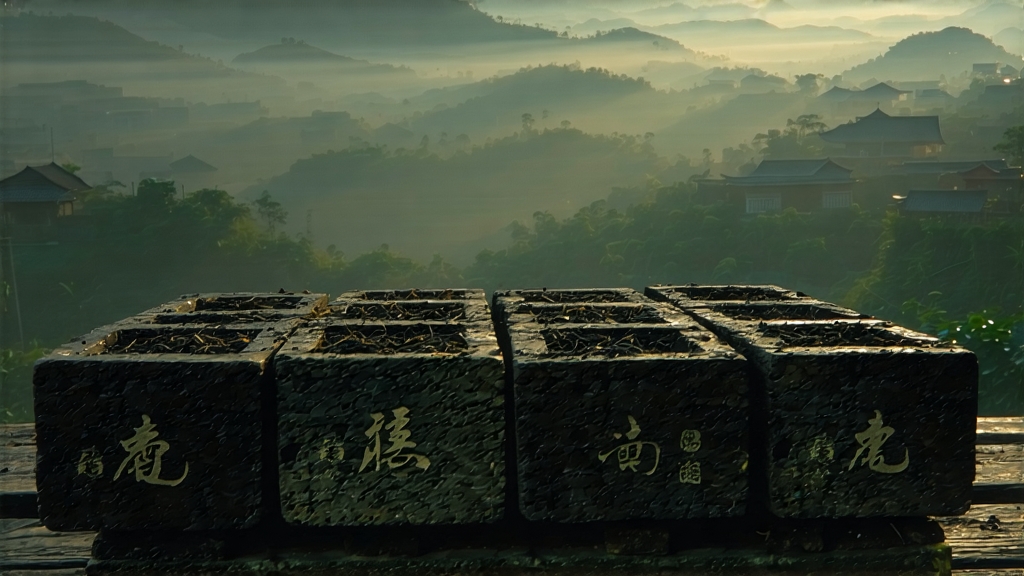
Tucked away in the humid, karst-pocked mountains of southern Guangxi, Liu Bao cha has spent four centuries quietly fermenting its way into the hearts of dockworkers, emperors and, more recently, global tea aficionados. To the uninitiated it is merely another dark brick on the shelf, yet to those who listen with palate and patience Liu Bao whispers stories of the ancient Tea-Horse Road, of swampy cellars where bamboo baskets breathe, and of a flavour that collapses time into a single cup.
History: From River Port to Imperial Tribute
The name itself is a map. Liu Bao was once the shipping port on the Liu River where compressed tea leaves were loaded onto bamboo rafts and floated down to Guangzhou, then on to Hong Kong and Southeast Asia. During the Qing dynasty the tea’s ability to calm stomachs on long voyages earned it the nickname “boat tea,” and in 1801 the Jiaqing Emperor placed it on the tribute list, requiring the best lots to be sent to Beijing each spring. Overseas Chinese in Malaysia discovered that the tea thrived in their tin-mine coolies’ damp dormitories; the hotter and steamier the storage, the smoother the liquor became. Thus a working-class ration transmuted into a collector’s treasure, and today 50-year-old Liu Bao bricks change hands for sums that would astonish the raftsmen who once stacked them.
Varietal and Leaf: The Yunnan Connection
Although Liu Bao is classified as a Guangxi dark tea, the leaf itself is the Da Ye cultivar—literally “big leaf”—the same Assamica genetics that gives Pu-erh its backbone. Cuttings travelled eastward in the late Ming, finding a second home in the lowlands of Wuzhou and Cangwu counties where the soil is lateritic, rich in iron and humus. The local subtropical climate delivers two distinct harvests: the spring “ming qian” buds yield a lighter, orchid-tinged liquor, while the summer “gu yu” leaf, thicker and more tannic, is prized for long aging. Farmers still judge readiness by the squeak the leaf makes when folded between thumb and forefinger; a sound like wet leather signals the perfect moment to pluck.
Craft: Where Smoke Meets Microbes
Unlike the shou Pu-erh it is often compared to, Liu Bao undergoes a unique “wet-pile” fermentation that is shorter, hotter and interrupted by a 24-hour charcoal-baking stage. Fresh leaves are withered under the sun for two hours, then wok-fried at 280 °C for exactly three minutes to kill green enzymes while preserving leaf integrity. The half-damp piles are stacked 70 cm deep in cedar-lined chambers; workers in bare feet walk the stacks every four hours, turning the tea so that core temperatures hover around 55 °C. On the third night the pile is broken up and loaded into pine-fired drying baskets where smoke coils through the leaf for one full day, imparting a resinous note that later mellows into what locals call “song xiang” or pine-river aroma. Finally the tea is steamed, pressed into 50 kg bamboo baskets lined with banana leaf, and transferred to humid underground cellars where a second, slower microbial fermentation continues for years. The dominant organism is Aspergillus niger, the same fungus that ripens pu-erh, but Liu Bao’s shorter piling leaves more polyphenols intact, giving the aged tea a brighter, betel-nut sweetness that lingers on the sides of the tongue.
Aging: The Bamboo Basket as Breathing Lung
Connoisseurs speak of three critical turning points: the “new tea” phase (0-3 years) when smoke still dominates; the “basket age” (3-15 years) when pine recedes and a dried-longan note emerges; and the “cellar age” (15+ years) where the liquor darkens to coffee-black and a camphor-cool sensation coats the throat. The baskets themselves are never sealed; airflow allows micro-oxidation while the banana leaf imparts a faint saline quality that accentuates sweetness. In the 1970s a batch forgotten in a Kuala Lumpur warehouse resurfaced after 38 years; the bricks had developed a golden frost of “jin hua” yellow mold, and the infusion tasted of molasses, tobacco and rainforest earth—an accidental discovery that now commands auction prices above USD 5,000 per kilogram.